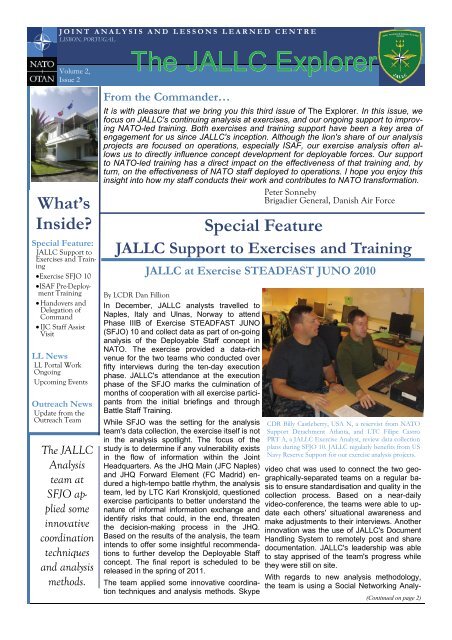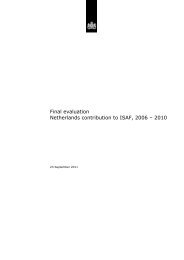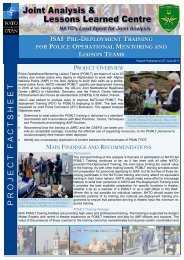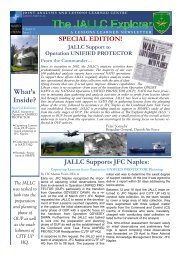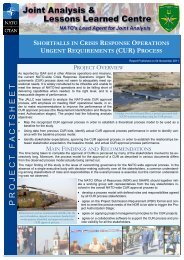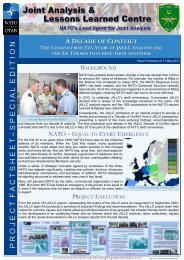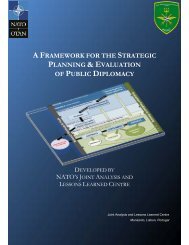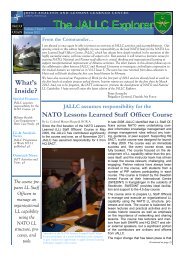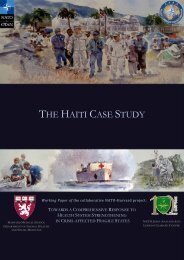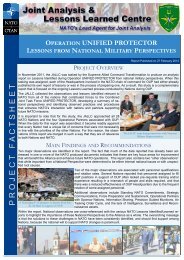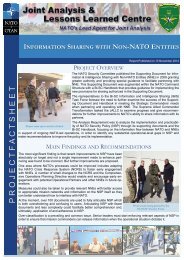The JALLC Explorer - Joint Analysis and Lessons Learned Centre
The JALLC Explorer - Joint Analysis and Lessons Learned Centre
The JALLC Explorer - Joint Analysis and Lessons Learned Centre
- No tags were found...
You also want an ePaper? Increase the reach of your titles
YUMPU automatically turns print PDFs into web optimized ePapers that Google loves.
JOINT ANALYSIS AND LESSONS LEARNED CENTRELISBON, PORTUGALVolume 2,Issue 2What’sInside?Special Feature:<strong>JALLC</strong> Support toExercises <strong>and</strong> TrainingExercise SFJO 10ISAF Pre-DeploymentTrainingH<strong>and</strong>overs <strong>and</strong>Delegation ofComm<strong>and</strong>IJC Staff AssistVisitLL NewsLL Portal WorkOngoingUpcoming EventsOutreach NewsUpdate from theOutreach Team<strong>The</strong> <strong>JALLC</strong><strong>Analysis</strong>team atSFJO appliedsomeinnovativecoordinationtechniques<strong>and</strong> analysismethods.<strong>The</strong> <strong>JALLC</strong> <strong>Explorer</strong>From the Comm<strong>and</strong>er…It is with pleasure that we bring you this third issue of <strong>The</strong> <strong>Explorer</strong>. In this issue, wefocus on <strong>JALLC</strong>'s continuing analysis at exercises, <strong>and</strong> our ongoing support to improvingNATO-led training. Both exercises <strong>and</strong> training support have been a key area ofengagement for us since <strong>JALLC</strong>'s inception. Although the lion's share of our analysisprojects are focused on operations, especially ISAF, our exercise analysis often allowsus to directly influence concept development for deployable forces. Our supportto NATO-led training has a direct impact on the effectiveness of that training <strong>and</strong>, byturn, on the effectiveness of NATO staff deployed to operations. I hope you enjoy thisinsight into how my staff conducts their work <strong>and</strong> contributes to NATO transformation.Peter SonnebyBrigadier General, Danish Air ForceSpecial Feature<strong>JALLC</strong> Support to Exercises <strong>and</strong> Training<strong>JALLC</strong> at Exercise STEADFAST JUNO 2010By LCDR Dan FillionIn December, <strong>JALLC</strong> analysts travelled toNaples, Italy <strong>and</strong> Ulnas, Norway to attendPhase IIIB of Exercise STEADFAST JUNO(SFJO) 10 <strong>and</strong> collect data as part of on-goinganalysis of the Deployable Staff concept inNATO. <strong>The</strong> exercise provided a data-richvenue for the two teams who conducted overfifty interviews during the ten-day executionphase. <strong>JALLC</strong>'s attendance at the executionphase of the SFJO marks the culmination ofmonths of cooperation with all exercise participantsfrom the initial briefings <strong>and</strong> throughBattle Staff Training.While SFJO was the setting for the analysisteam's data collection, the exercise itself is notin the analysis spotlight. <strong>The</strong> focus of thestudy is to determine if any vulnerability existsin the flow of information within the <strong>Joint</strong>Headquarters. As the JHQ Main (JFC Naples)<strong>and</strong> JHQ Forward Element (FC Madrid) endureda high-tempo battle rhythm, the analysisteam, led by LTC Karl Kronskjold, questionedexercise participants to better underst<strong>and</strong> thenature of informal information exchange <strong>and</strong>identify risks that could, in the end, threatenthe decision-making process in the JHQ.Based on the results of the analysis, the teamintends to offer some insightful recommendationsto further develop the Deployable Staffconcept. <strong>The</strong> final report is scheduled to bereleased in the spring of 2011.<strong>The</strong> team applied some innovative coordinationtechniques <strong>and</strong> analysis methods. SkypeCDR Billy Castleberry, USA N, a reservist from NATOSupport Detachment Atlanta, <strong>and</strong> LTC Filipe CastroPRT A, a <strong>JALLC</strong> Exercise Analyst, review data collectionplans during SFJO 10. <strong>JALLC</strong> regularly benefits from USNavy Reserve Support for our exercise analysis projects.video chat was used to connect the two geographically-separatedteams on a regular basisto ensure st<strong>and</strong>ardisation <strong>and</strong> quality in thecollection process. Based on a near-dailyvideo-conference, the teams were able to updateeach others' situational awareness <strong>and</strong>make adjustments to their interviews. Anotherinnovation was the use of <strong>JALLC</strong>'s DocumentH<strong>and</strong>ling System to remotely post <strong>and</strong> sharedocumentation. <strong>JALLC</strong>'s leadership was ableto stay apprised of the team's progress whilethey were still on site.With regards to new analysis methodology,the team is using a Social Networking Analy-(Continued on page 2)
THE <strong>JALLC</strong> EXPLORERPage 2(Continued from page 1)sis tool called NodeXL to not only present the informalinformation exchanges in a graphical way, but also tocompare how information actually flows in the JHQ tohow doctrine says it should. This will be the first time ananalysis such as this will be used in NATO.Each team received direct support from <strong>JALLC</strong>'s leadershipduring their data collection. <strong>The</strong> team at JWC inUlsnes was visited by Comm<strong>and</strong>er, <strong>JALLC</strong>, BrigadierGeneral Peter Sonneby during the exercise. <strong>The</strong> Naplesteam welcomed Colonel Frédéric Curtaz, Head of theExercises <strong>and</strong> Training Branch at <strong>JALLC</strong>. Both wereimpressed with the teams' progress <strong>and</strong> motivation.<strong>The</strong> teams appreciated their encouragement <strong>and</strong> commendations.<strong>JALLC</strong>'s next analysis endeavour in the exercise continuumwill be STEADFAST JOIST 11 scheduled for May.<strong>JALLC</strong> Member in the SpotlightMarvin ThordsenContractorMr. Thordsen has worked on NATOanalysis projects since 2004 <strong>and</strong>has been full time at the <strong>JALLC</strong>since April 2006. He has 25 years’experience analyzing “teams” fromthe perspective of their being complex,dynamic, thinking organizations,including: wildfire fighting;computer hackers, AWACs, carrierl<strong>and</strong>ing signal officers, <strong>and</strong> Aegisanti-air defense systems.He is an Ohioan by birth <strong>and</strong> an “applied behavioralscientist” by training. Applied Behavioral Science is afairly new discipline that looks for solutions to real-worldproblems in social sciences such as sociology, psychology,human factors, cultural anthropology, combinedwith computer programming, training development, cognition,statistics, <strong>and</strong> cynicism.<strong>The</strong> benefit for NATO is that the “soft” science disciplineMr. Thordsen brings to the <strong>JALLC</strong> complements the“hard” scientific approaches of the traditional OperationResearch Analysts. His work has analysed C2; ReachBack; Operational Assessment; Fratricide; Logistics,Targeting, etc. <strong>The</strong> organizations examined include:NRF, DJTF, DJSE, all three JFCs, etc.Mr. Thordsen developed the following training: AnOverview of Interviewing/Surveying; Data CollectionPlanning, <strong>and</strong> (in development) Interviewing – Planning& Execution. In addition, he has co-authored: <strong>Analysis</strong>is not Evaluation <strong>and</strong> authored: A <strong>JALLC</strong> point paperon Programme of Analyses for NATO’s DeployableForces Concept; Introductory Guide to Interviewing;<strong>Analysis</strong> Requirements Check-list, <strong>and</strong> the unpublished<strong>The</strong> Importance of Team Leadership in Project Management.Outreach News<strong>The</strong> JATT team has been busy since Christmas, workingoff the excess turkey by undertaking training <strong>and</strong> mentoringvisits to a variety of audiences.<strong>The</strong> team went to JFCs Lisbon <strong>and</strong> Brunssum, workingclosely with the <strong>Joint</strong> Policy Application <strong>and</strong> <strong>Lessons</strong><strong>Learned</strong> branches to enhance their LL capability <strong>and</strong> inFebruary contributed again to the NATO LL Staff Officer’sCourse in Sweden. 27 students from NATO comm<strong>and</strong>s<strong>and</strong> the Nations attended this week-long course.In February JATT visited Hungary to train 50 students atthe Hungarian <strong>Joint</strong> Operational Comm<strong>and</strong> at Székesfehérvár,<strong>and</strong> 15 students at the Operations <strong>and</strong> DoctrineDivision of the MOD in Budapest.A visit to the Netherl<strong>and</strong>s allowed the JATT to examinenew Dutch web-based LL system. JATT also attendedthe Military Cooperation Coordination Workshop inSwitzerl<strong>and</strong>, where Partners expressed strong interest inhaving a LL capability <strong>and</strong> cooperation with <strong>JALLC</strong>.In April, JATT will visit the Ukraine <strong>and</strong> Italy. In May, theJATT will host a meeting for JFC <strong>and</strong> SHAPE LL stakeholders.This will be immediately followed by a NATOLLSO Course Review Conference, during which thecourse instructor team <strong>and</strong> stakeholders will review, revise<strong>and</strong> improve this very successful course.To request JATT support, contact us at jattpoc@jallc.nato.intNew on the LL PortalAn Operation UNIFIED PROTECTOR section has beencreated on the classified NATO <strong>Lessons</strong> <strong>Learned</strong> Portal<strong>and</strong> Database <strong>and</strong> is ready for your submissions.Two new features now on the unclassified NATO LLDB<strong>and</strong> coming soon on the classified LLDb: on-line registration<strong>and</strong> email alerts for updates on database items.Coming soon on the unclassified NATO LL Portal—theBest Practice Community of Interest where you can submitbest practices <strong>and</strong> find others'.Create your own LL Community of Interest on the NATOLL Portal. Contact: nllp@jallc.nato.intRemember – we need your contributions to the NATO<strong>Lessons</strong> <strong>Learned</strong> Portal: nllp.jallc.intUpcoming Events<strong>JALLC</strong> Analyst Course in Lisbon – 04–09 April 2011LL Staff Officer Course in Sweden – 27 June – 01 July 2011Recent <strong>JALLC</strong> ReportsIn the last six months, <strong>JALLC</strong> has published the following reports: ISAF Comm<strong>and</strong> <strong>and</strong> Control – 01 October 2010 <strong>The</strong> LL Process <strong>and</strong> LL Sharing in Nations – 18 Nov. 2010 Information Flow <strong>and</strong> C2 in the JHQ – 21 March 2011Read these <strong>and</strong> other <strong>JALLC</strong> publications from the<strong>JALLC</strong> archives at http://www.jallc.nato.int
<strong>JALLC</strong> Support to Exercises <strong>and</strong> TrainingSupport to ISAF Pre-Deployment TrainingBy LTC Matias Skogseid NOR ASince the start of ISAF a number of ISAF Predeploymenttraining programmes have been developedfor ISAF HQs, Regional Comm<strong>and</strong>s, ProvincialReconstruction Teams <strong>and</strong> Operational Mentoring <strong>and</strong>Liaison Teams. <strong>The</strong> <strong>JALLC</strong> Training <strong>Analysis</strong> Team(TAT) has supported improving these programs withfeed back <strong>and</strong> recommendations at the event <strong>and</strong> lateron with reports to JFC Brunssum, as the main customer,<strong>and</strong> stakeholders like ACO, ACT, JWC. JFTC<strong>and</strong> NSO. <strong>The</strong>se feed backs <strong>and</strong> reports are productsbuilt on analysis <strong>and</strong> a proactive <strong>Lessons</strong> <strong>Learned</strong> (LL)process based on observations during the training <strong>and</strong>interviews with NATO <strong>and</strong> National HQ personnel aswell as Primary Training Audience (PTA) in theatre.<strong>The</strong> <strong>JALLC</strong> TAT continued to support ISAF PDT in2010. Main focus for the first part of the year was theISAF Intelligence Orientation Course (I2OC), the RegionalComm<strong>and</strong> (RC) North Mission Rehearsal Training(MRT) <strong>and</strong> the HQ ISAF / ISAF <strong>Joint</strong> Comm<strong>and</strong>MRT. This analysis period culminated in July <strong>and</strong> includedobservations during Training Events (TE) aswell as a significant number of in-theatre interviews.<strong>The</strong> observations <strong>and</strong> interviews resulted in the ISAFI2OC Event Report in February, the RC North PDTEvent Report in May <strong>and</strong> the <strong>JALLC</strong> Report on ISAFPDT in the new C2 structure in August 2010. <strong>The</strong>sereports were Bi-SC endorsed <strong>and</strong> had direct impact inimproving the development of the training events.<strong>JALLC</strong> reports are distributed to ISAF contributing nationsas well, <strong>and</strong> point out areas nations should improve.One significant improvement witnessed is therising number of Individual Augmentees participating inthe TEs. This has a positive <strong>and</strong> direct effect on theoperation as untrained personnel struggle for weeksafter they are deployed before they are able to contribute<strong>and</strong> produce as expected. Another issue highlightedin several reports is the <strong>Joint</strong> Advanced DistributedLearning (JADL), the internet based core buildingblock m<strong>and</strong>atory in PDT. <strong>The</strong>re has been significantprogress in trainees accomplishing the JADL Package.In 2010 the training concept for Police OperationalMentoring <strong>and</strong> Liaison Teams was introduced. <strong>The</strong>TAT was tasked to analyse the Phase II Pilot TE atJFTC, Bydgoszcz, Pol<strong>and</strong> end of May <strong>and</strong> the TEs atJMRC, Hohenfels, Germany <strong>and</strong> CNEFG, Saint Astier,France in November. Recommendations provided inthe AAR processes <strong>and</strong> to the Police Operational Mentoring<strong>and</strong> Liaison Teams Training Core PlanningTeam were well received <strong>and</strong> made a significant contributionto the further development of the training concept.A <strong>JALLC</strong> Report on POMLT PDT will be issuedlate spring 2011, after interviews in ISAF are finished.Volume 2, Issue 2April 2011Page 3H<strong>and</strong>overs <strong>and</strong> Delegation ofComm<strong>and</strong> at NRF ExercisesBy Mr Marvin ThordsenFor anyone involved in a transition / h<strong>and</strong>over from oneHQ/force to a follow-on one, the lessons from past exercisesmay be helpful.In STEDFAST JAW (SFJW) 07 , two component comm<strong>and</strong>sh<strong>and</strong>ed off to their follow-on counterparts. InSTEADFAST JUNCTURE (SFJE) 10, COM JFC delegatedNRF mission comm<strong>and</strong> authority to his DCOM .In SFJW 07, the lessons fell into two broad categories:Areas requiring “common underst<strong>and</strong>ings / agreements”<strong>and</strong> areas requiring detailed stipulation in advance. <strong>The</strong>former included:Differences in the organizational <strong>and</strong> C2 structuresof the initial entry & follow-on force component HQs;Clarification of which organization’s C2 structures,procedures, <strong>and</strong> CIS would be in effect <strong>and</strong> whowould “lead” during the transition;Timing, sequencing <strong>and</strong> coordination of h<strong>and</strong>overs;Transition coordination mechanisms;An agreed upon transition strategy.Areas in which specific details were required:Coordination authority specificationTransition tasks specificationAssignments & responsibilities specificationInitial Entry <strong>and</strong> Follow-on Force Transfer of Authorityannex coordinationSupported/supporting relationships synchronizationWISE/SharePoint page coordination;Rear Area C2 coordination.<strong>The</strong> delegation of comm<strong>and</strong> lessons from SFJE 10 centeredon mitigating the impact the h<strong>and</strong>off might have onthe mission. <strong>The</strong> following were identified as contributingto a smooth h<strong>and</strong>over <strong>and</strong> ensuring adherence to doctrinalcomm<strong>and</strong> <strong>and</strong> control principles.It proved useful to include, as part of the forward SpecialStaff, an individual involved in the development of theOPLAN <strong>and</strong> Concept of Oerations to strengthen continuitybetween “planning” <strong>and</strong> “execution”.Providing the incoming COM access to all mission documents<strong>and</strong> including him in relevant meetings <strong>and</strong> briefingsto enhance shared situation awareness betweenthe outgoing <strong>and</strong> incoming COMs was valuable.It's important to ensure that COM’s intentions, freedoms,constraints, <strong>and</strong> objectives are clearly articulated <strong>and</strong>the required forces, resources <strong>and</strong> authorities are availableto his designated COM representative.As there will be h<strong>and</strong>overs between two CC HQ/Forces<strong>and</strong> mission comm<strong>and</strong>ers in the upcoming STEADFAST(Continued on page 4)
<strong>JALLC</strong> NewsletterJOINT ANALYSIS & LESSONS LEARNED CENTREby LTC Matthias Fieser DEU AOn 28 January 2011 the <strong>JALLC</strong> was tasked by SHAPEto support a Staff Assistance Visit (SAV) of the US <strong>Joint</strong>Forces Comm<strong>and</strong> (JFCOM). This was the first time a Bi-SC NATO team participated in such an event.A SAV team from JFCOM is a flexible employmentpackage composed of personnel from operations, plans,knowledge/information management <strong>and</strong> logistics. Thishighly skilled team can rapidly increase comm<strong>and</strong> <strong>and</strong>control capability at the operational level of a newlyformed joint force headquarters.<strong>The</strong> JFCOM team was requested by the ISAF <strong>Joint</strong>Comm<strong>and</strong> (IJC) to have a closer look into their dailywork, with the intention to enhance their overall operationaleffectiveness <strong>and</strong> facilitate the continuing developmentof the IJC HQ staff as an operational level comm<strong>and</strong>.After a first visit in 2010, it was now time to seehow the IJC has matured.<strong>The</strong> <strong>JALLC</strong>, supported by SHAPE <strong>and</strong> the C2COE, deployedto IJC, linked up with the JFCOM, <strong>and</strong> got right<strong>JALLC</strong><strong>Joint</strong> <strong>Analysis</strong> <strong>and</strong> <strong>Lessons</strong> <strong>Learned</strong> <strong>Centre</strong>Avenida Tenente MartinsMonsanto1500-589 LisbonPhone: +351 21 771 7007/8/9Fax: +351 21 771 7098http://www.jallc.nato.intVolume 2, Issue 2 April 2011Page 4<strong>JALLC</strong>/JFCOM Staff Assistance Visit to IJCH<strong>and</strong>overs <strong>and</strong> Delegation of Comm<strong>and</strong> at NRF ExercisesContinued from page 3)JOIST (SFJT) 11, these lessons are relevant. SFJT 11covers new ground as there will also be a h<strong>and</strong>over betweenthe <strong>Joint</strong> HQ (JHQ) MAIN to a different MAINwhile the JHQ Forward Element will remain in place.Two-thirds of the split JHQ will be transitioning <strong>and</strong> onethirdwill remain in place. <strong>The</strong> implications are that, underthe DJSE concept, the mission COM <strong>and</strong> specialstaff come from the MAIN, but if you change MAIN, theyshould be from the incoming MAIN. SFJT 11 will undoubtedlyprovide lessons on a variety of new topics:Transition <strong>and</strong> h<strong>and</strong>offs amongst initial entry specialstaff to their follow-on counterparts in the FE.Maintaining continuity of non-transiting componentLNOs in the “MAIN” as responsibility transitions frominitial entry to follow on.Coordination of the h<strong>and</strong>overs between transitioningcomponent LNO representatives in the FE.Coordination of the directorate / branch h<strong>and</strong>overs.to work. <strong>The</strong> <strong>JALLC</strong> team contributed with its expertisein three out of six areas: key processes, crisis establishment,<strong>and</strong> training. After a week of hard work, the finalout brief about the findings <strong>and</strong> recommendations wasbriefed to the IJC comm<strong>and</strong> group.In his conclusions COS IJC underlined the importanceof this joint effort <strong>and</strong> stated that the recommendationsshould be taken into consideration to further improvethe overall effectiveness of this headquarters.Maintenance of FE situation awareness of the statusof the MAIN <strong>and</strong> component transitions?Impact of the MAIN <strong>and</strong> component transitions on thenon-transitioning in-theatre elementsChallenges of moving the functional services (e.g.,Tasker-Tracker, Common Mailboxes, telephone exchanges,etc.) that are hosted in the initial entry MAINto the follow-on MAIN?Coordination <strong>and</strong> maintenance of continuity, situationawareness <strong>and</strong> tasking of Boards <strong>and</strong> WorkingGroups during the transitioning the context of thechange in makeup/membership.<strong>The</strong> mechanisms employed to enable the FE to establish<strong>and</strong> maintain relationships with their counterpartsin both MAINs to smoothly transition.Some of the lessons will be NRF/DJSE specific, butmany will relate to a split HQ <strong>and</strong> the structures dictatedby the PE, more so than just the DJSE concept. It will beinteresting to see what new lessons we can identify.NATO’s Lead Agent for <strong>Joint</strong> <strong>Analysis</strong><strong>The</strong> <strong>Joint</strong> <strong>Analysis</strong> <strong>and</strong> <strong>Lessons</strong> <strong>Learned</strong> <strong>Centre</strong>(<strong>JALLC</strong>) is NATO’s centre for performing jointanalysis of operations, training, exercises <strong>and</strong> ConceptDevelopment <strong>and</strong> Experimentation, includingestablishing <strong>and</strong> maintaining an interactive managed<strong>Lessons</strong> <strong>Learned</strong> Database.


